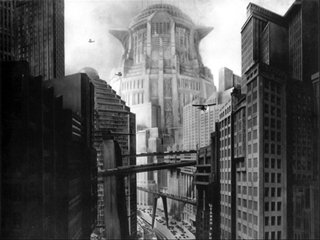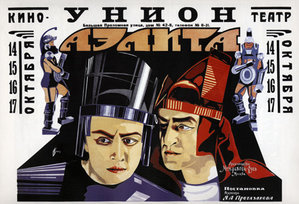Classics
A silent film is a film with no accompanying, synchronized recorded spoken dialogue. more...
The idea of combining motion pictures with recorded sound is nearly as old as the motion picture itself, but because of the technical challenges involved, most films were silent before the late 1920s.
History
The years before sound came to the movies are known as the silent era among film scholars and historians. The art of motion pictures grew into full maturity before silent films were replaced by talking pictures or talkies and many film buffs believe the esthetic quality of cinema actually decreased for several years as the new medium of sound was adapted to the movies. The visual quality of silent movies (especially those produced during the 1920s) was often extremely high but later televised presentations of poor, second or even third generation copies made from already damaged and neglected stock (usually played back at incorrect speeds and with inappropriate music) led to the widely held misconception that these films were primitive and barely watchable by modern standards.
Intertitles
Since silent films had no synchronized sound for dialogue, onscreen intertitles were used to narrate story points, present key dialogue and sometimes even comment on the action for the cinema audience. The title writer became a key professional in silent film and was often separate from the scenario writer who created the story. Intertitles (or titles as they were generally called at the time) often became graphic elements themselves, featuring illustrations or abstract decorations that commented on the action of the film or enhanced its atmosphere.
Live music and sound
Showings of silent films almost always featured live music, starting with the pianist at the first public projection of movies by the Lumière Brothers on December 28, 1895 in Paris (Cook, 1990). From the beginning, music was recognized as essential, contributing to the atmosphere and giving the audience vital emotional cues (musicians sometimes played on film sets during shooting for similar reasons). Small town and neighborhood movie theaters usually had a pianist. From the mid-teens onward, large city theaters tended to have organists or entire orchestras. Massive theatrical organs such as the famous "mighty Wurlitzer" could simulate some orchestral sounds along with a number of sound effects.
The scores for silents were often more or less improvised early in the medium's history. Once full features became commonplace, however, music compiled from Photoplay music by the pianist, organist, orchestra conductor or the movie studio itself, which would send out a cue sheet with the film. Starting with Joseph Carl Breil's score for D.W. Griffith's groundbreaking epic The Birth of a Nation (USA, 1915) it became relatively common for films to arrive at the exhibiting theater with original, specially composed scores (Eyman, 1997).
By the height of the silent era, movies were the single largest source of employment for instrumental musicians (at least in America) and the introduction of talkies, which happened simultaneously with the onset of the Great Depression, was devastating.
Film industries in some countries devised other ways of bringing sound to silents. The early cinema of Brazil featured fitas cantatas, filmed operettas with singers lip-synching behind the screen (Parkinson, 1995, p. 69). In Japan, films had not only live music, but the benshi, a live narrator who provided commentary and character voices. The benshi became a central element in Japanese film form, as well as providing translation for foreign (mostly American) movies (Standish, 2005). Their popularity was one reason why silents persisted well into the 1930s in Japan.
Acting techniques
The medium of silent film required a greater emphasis on body language and facial expression so the audience could better understand what an actor was feeling and portraying on screen. Combined with cultural differences arising from the passage of time, modern-day audiences may be disoriented watching some films from the silent era. Silent comedies tend to be more popular in the modern era than drama, partly because overacting is more natural in comedy. However, some silent films were quite subtly acted, depending on the director and the skill of the actors. Overacting in silent films was sometimes a habit actors transferred from their stage experience and directors who understood the intimacy of the new medium discouraged it.
Projection speed
Up until around 1925, most silent films were shot at slower speeds (or "frame rates") than sound films, typically at 16 to 23 frames per second depending on the year and studio, rather than 24 frames per second. Unless carefully shown at their original speeds they can appear unnaturally fast and jerky, which reinforces their alien appearance to modern viewers. At the same time, some scenes were intentionally undercranked during shooting in order to accelerate the action, particularly in the case of slapstick comedies. The intended frame rate of a silent film can be ambiguous and since they were usually hand cranked there can even be variation within one film. Film speed is often a vexed issue among scholars and film buffs in the presentation of silents today, especially when it comes to DVD releases of "restored" films; the 2002 restoration of Metropolis (Germany, 1927) may be the most fiercely debated example.
Most films seem to have been shown at 18 fps or higher - some even faster than what would become sound film speed (24 fps). Even if shot at 16 fps (often cited as "silent speed"), the projection of a nitrate base 35mm film at such a slow speed carried a considerable risk of fire. Oftentimes projectionists would receive instructions from the distributors as to how fast particular reels or scenes should be projected on the musical director's cue sheet. Theaters also sometimes varied their projection speeds depending on the time of day or popularity of a film in order to maximize profit.
Read more at Wikipedia.org



